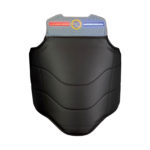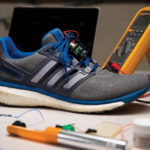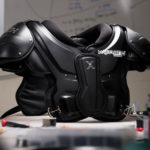
Today, people of all ages are embracing active lifestyles: playing team sports, hitting the slopes, biking, climbing and hiking in all kinds of weather conditions, testing their mettle in boxing rings and martial arts classes or going for the gentler forms of exercise, like yoga. People are on the move, including retiring baby boomers who want to stay active, and are looking for products that not only help improve their performance, comfort level and experience, but—most important—keep them safer as well. That consumer demand has sparked ongoing innovation among those providing fibers, fabrics and end products to all these sports and recreation markets. And that, in turn, has encouraged even greater athletic participation, keeping demand growing and pressuring manufacturers to deliver more to meet consumer expectations.
Head-to-toe, strength and style
“One of the biggest trends is finding the optimum strength and the durability of textile materials,” says Davide Brugnoli, product manager for Dainese. “From run-resistant to anti-stress, these are transforming the market, where previously yarns with that kind of purpose were tough and rigid.”
Technology has evolved to the extent that today’s safety gear is nothing like that of yesterday, says Brugnoli. Back protectors, helmets and similar products were once perceived as cumbersome, unappealing and weighty—attributes that often reduced wear-times or discouraged donning the gear altogether—but now protective gear is widely accepted as stylish and comfortable, and has become an integral part of what is worn and often required for the sport. On the one hand, this is a positive and profitable change of mindset for product manufacturers, but at the same time it can be challenging.
“Users want to use safety products all day long,” says Brugnoli. “Therefore, brands have to make something really light while still meeting the highest international safety standards. That’s the challenge.”
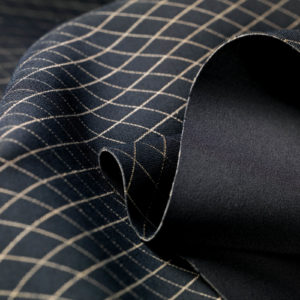
Dainese, headquartered in Vicenza, Italy, designs advanced protective gear for motorcycling, winter sports, cycling, horse riding and sailing, offering head-to-toe coverage. One of the company’s newest additions is the Pro-Armor waistcoat back protector, developed for skiers.
“The protector’s complex structure is inspired by nature’s fractals, and offers maximum breathability and airflow (43 percent vented surface), while the semirigid hybrid construction offers extended protection over the entire spinal column,” says Brugnoli.
The company also offers, among other items, the Flexagon back protector, incorporating overlapping layers of Crash Absorb® memory foam, which is hexagon-shaped soft pads that move independently of each other to follow the body’s anatomy. Dainese also offers the Scarabeo Flex Lite back Protector–for youth, featuring Flex Lite technology and two overlapping layers of Crash Absorb memory foam and Polartec® Power Wool™.
Crash Absorb soft memory foam is constructed from water-repellent, elastic-visco nitrile rubber and has shape-retention and energy-absorption functionality. Polartec Power Wool combines natural and synthetic fibers, resulting in what Brugnoli describes as a “bi-component fabric.” According to Brugnoli, blending different yarns into one composite material can negatively affect the desired benefit outcomes and hamper fabric performance.
“But by isolating a merino wool interior and a synthetic fiber exterior, we developed a hybrid fabric with distinct surface features to optimize wicking, breathability, odor resistance and durability,” he says. “Wool fibers offer increased base comfort by retaining insulation and breathability, even when wet, pulling moisture vapor away from the skin and transferring it to the outer synthetic layer where it expands and evaporates more quickly.”
Technological advancements and innovation mean little without functionality, Brugnoli adds; this is why most successful brands devote significant time to researching the human body and how it responds to high-intensity activities and stressful situations.
“Technology must adapt to every possible condition in order to answer the needs of the most demanding user,” he says.
Taking a hit
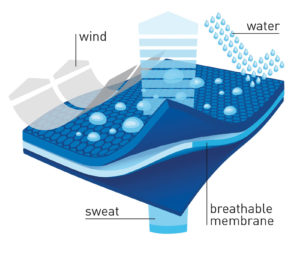
Located in Gilman, Conn., Marty Gilman Inc. (dba Gilman Gear) manufactures a variety of football equipment such as blocking and tackling sled pads, dummies and shields, goal post pads, landing mats and carry-all-bags. The company supplies the entire National Football League as well as about 500 college and 10,000 high school football programs, says Neil Gilman, president.
“Our products need to be tough,” he says. “They’re violently hit and beat up. They’re used outside in hot and cold weather, rain, snow and windy conditions. We look for materials with high tear strength and abrasion resistance, as well as materials that won’t crack in cold temperatures or lose strength in high temperatures.”
Although the materials play a contributing role in product safety, the design is what makes the product safe, says Gilman, using as an example the Roll Tackle Ring, introduced in 2015. Shaped like a large donut, it allows football players to practice tackling on something that actually moves—unlike most tackling dummies, which are stationary.
“Because of its donut hole, a tackler can get a good arm wrap on it and knock it to the ground,” Gilman explains. “Because the inside is soft foam, there’s no impact on the football player making the tackle.”
Before this innovation, tackling was done on sleds, dummies or actual humans. But with the growing concern over head trauma and concussions, a better, safer alternative was needed than going against another player, Gilman says.
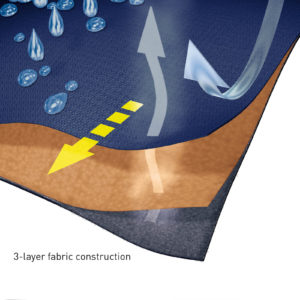
One issue businesses in this arena are contending with is the widespread demand for school colors, pressuring manufacturers to stock colors like navy blue, maroon, forest green and purple not offered by suppliers. Another concern is the availability of neoprene.
“This is a big one for us,” says Gilman. “We use this material for the bottom of our dummies because they’re often dragged on turf or hard surfaces. We can only find one company that still manufactures it, and it sells at a premium. We’d love to see a coated product with equivalent strength and abrasion resistance.”
Protecting with padding
Humphreys CoverSports and Globe Canvas Products Co. makes fabric protective coverings such as windscreens, banners and fence top protection for various athletic venues. The Philadelphia-based company also manufactures gym floor covers, wall padding, stadium pads and gym mats, primarily made from PVC-coated polyester fabrics.
“Safe wall padding for gymnasiums should conform to ASTM F2440 for impact resistance,” says CEO Ron Nissenbaum. “However, not all specifiers, including architects, know to specify wall padding for new or replacement applications that conform to that safety expectation. They simply specify ‘provide two-inch-thick foam.’ That leaves the door wide open to the cheapest grades of foam, which from a safety perspective, is not really appropriate.”
CoverSports uses a recycled-fiber-like foam, with a minimum of 60-percent content made from recycled soda bottles, for the interior of its wall paddings and gym mats. The foam has all the safety characteristics of conventional foam, says Nissenbaum, but is more ecologically friendly, which is of increasing interest to buyers (See “Sustainable reality for textiles,” page 61.) The company’s floor covers and wall padding also offer a “fire retardancy usually specified to NFPA 701,” he adds.
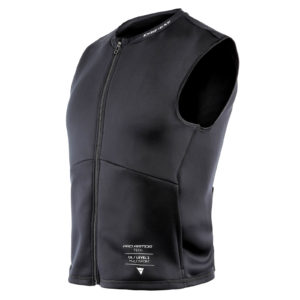
Like Gilman, Nissenbaum recognizes the trend toward fabrics printed with school logos and sponsors, fueled in part by the advancements in digital printing equipment (and the lower prices of that equipment) that are delivering better and longer-lasting results for fabrics used
in a sports environment.
“This has led to an explosion in arena and stadium branding—from simple windscreens on a high school outfield to the banners and padding for the biggest indoor and outdoor stadiums,” says Nissenbaum. “Sign painting is gone like the pay phone.”
Printer prices may have become more accessible, but ink is another story; it sometimes costs more than the fabric itself, he says. Consequently, quick fading is unacceptable, making fabric quality of paramount importance. For example, printed PVC stadium pads should have high UV protection, particularly in outdoor arenas, which does cost more. Still, some providers will use cheaper fabric to cut pricing, says Nissenbaum, which can lead to fading in a relatively short time.
CoverSports continually upgrades its technology, investing more than $1.5 million last year in new computer systems and in printing and cutting equipment. The company keeps an eye out for innovative fabrics as well.
“Wherever light weight and strength can be combined, that is a winner,” Nissenbaum says. “We are always searching for the right combination
of strength, weight and price.”
Focusing on function
Headquartered in Sevelen, Switzerland, Schoeller Textil AG specializes in the development and environmentally sustainable manufacturing of functional fabrics and textiles for the athletic, outdoor, fashion and workwear markets, says Stephen Kerns, president of Schoeller Textil USA in Newburyport, Mass.
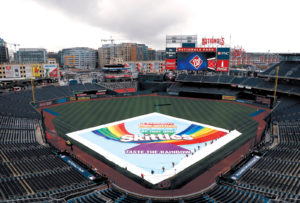
“We’re known extensively for our stretch woven articles that can be enhanced to include laminate options, such as c_change® for waterproof protection; corkshell™ for insulation properties and PCM™ Phase Change Material for more advanced thermal regulations,” says Kerns. “Recently, we’ve expanded to offer electro-spin membrane technology as well.”
This latest technology—the brand-new Tauropran® membrane—was developed jointly with Red Bull. The membrane offers maximum protection from wind and weather while remaining “extraordinarily breathable and ultralight,” Kerns says. C_change technology is inspired by a pinecone’s reaction to temperature change and to dry/wet conditions.
Some of the materials these fabrics incorporate are polyamides, polyester and elastane, as well as biofoams, selected not only for their performance characteristics but also because the company “works in an environment centered around bluesign® parameters as the norm,” says Kerns. The bluesign system seeks to make textile production more sustainable. Schoeller’s textiles end up in products used for snow sports, urban technical and road cycling, Nordic and alpine skiing racing suites and Pinnacle mountain outerwear, among others.
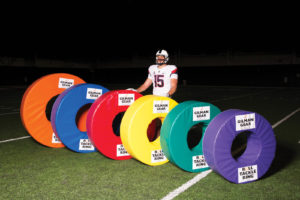
“There remains a large focus on quality and having the lightest weight, most durable, highest breathability and sustainability stories. The shopping experience is changing to robust product information at consumers’ fingertips, which is pushing knowledge and expectations. We see the future as being as exciting as ever,” says Kerns. Schoeller continues to see real value in its long-ago decision to commit heavily to research and development.
Pamela Mills-Senn is a freelance writer based in Long Beach, Calif.
Jake Merrell is president of Nano Composite Products Inc. (NCP), an Orem, Utah, company that provides smart technology and consulting services to the foam industry. He is also the owner of the XOnano® Smartfoam technology, and the company’s portfolio also includes the XOComfort foam, a thermally conductive foam for comfort.
Inspired by a discovery Merrell made in December 2012 while working as an undergraduate research assistant in a nano-composite lab at Brigham Young University in Provo, Utah, the technology was sparked by a discussion about using the lab’s elastic sensors to monitor concussion problems.
“After the discovery, the material became the focus of my research, culminating in my dissertation for my Ph.D.,” he explains. “I created XOnano Smartfoam to bring the technology to market.”
How it works
• The Smartfoam is enabled by embedding conductive nano/microparticles into foam when it is cast.
• The particles create an internal triboelectric (created when two different materials rub against each other) or piezoresistive (resistance to the flow of electrons through a material) response to impacts and pressure respectively.
• The triboelectric impact-sensing variant generates a voltage that correlates to the impact’s energy and is measured internally with a microcontroller or some other form of voltage-measuring device. The microcontroller is separate from the foam and can vary, depending on who is using the Smartfoam.
• The pressure-sensing variant is measured through a piezoresistive response, where the foam’s resistance decreases with increased pressure; lower resistance indicates higher pressure.
Where it works
The foam can be used in a variety of applications, such as instrumented insoles, helmets, shoulder pads and brushings. Currently, the impact-sensing foam is offered commercially through a partnership with the Rogers Corp., a Chandler, Ariz.-based provider of solutions for power electronics, advanced foams for cushioning and protective sealing, and high-frequency printed circuit materials. It is already available in a Taekwondo vest made by 20/20 Armor, a provider of martial arts gear headquartered in Toronto, Ontario, Canada.
“The signal created by the foam is a voltage measurement, and that signal is interpreted as a measure of impact or pressure. That measurement is then used by each application in different ways,” says Merrell. “The Taekwondo vest uses it to score how fast and hard kicks or punches are applied to the vest. In the insole, the data is used to evaluate a user’s gait. In a helmet, it could be used to alert coaches or trainers that someone got hit above a threshold that could cause injury.
“[The foam] enables us to place sensors in products that have never before been measured,” he continues. “Our expectation is that this new form of data collection will enable our clients to make better products and provide better decision-making criteria for consumer safety or entertainment.”
 TEXTILES.ORG
TEXTILES.ORG



